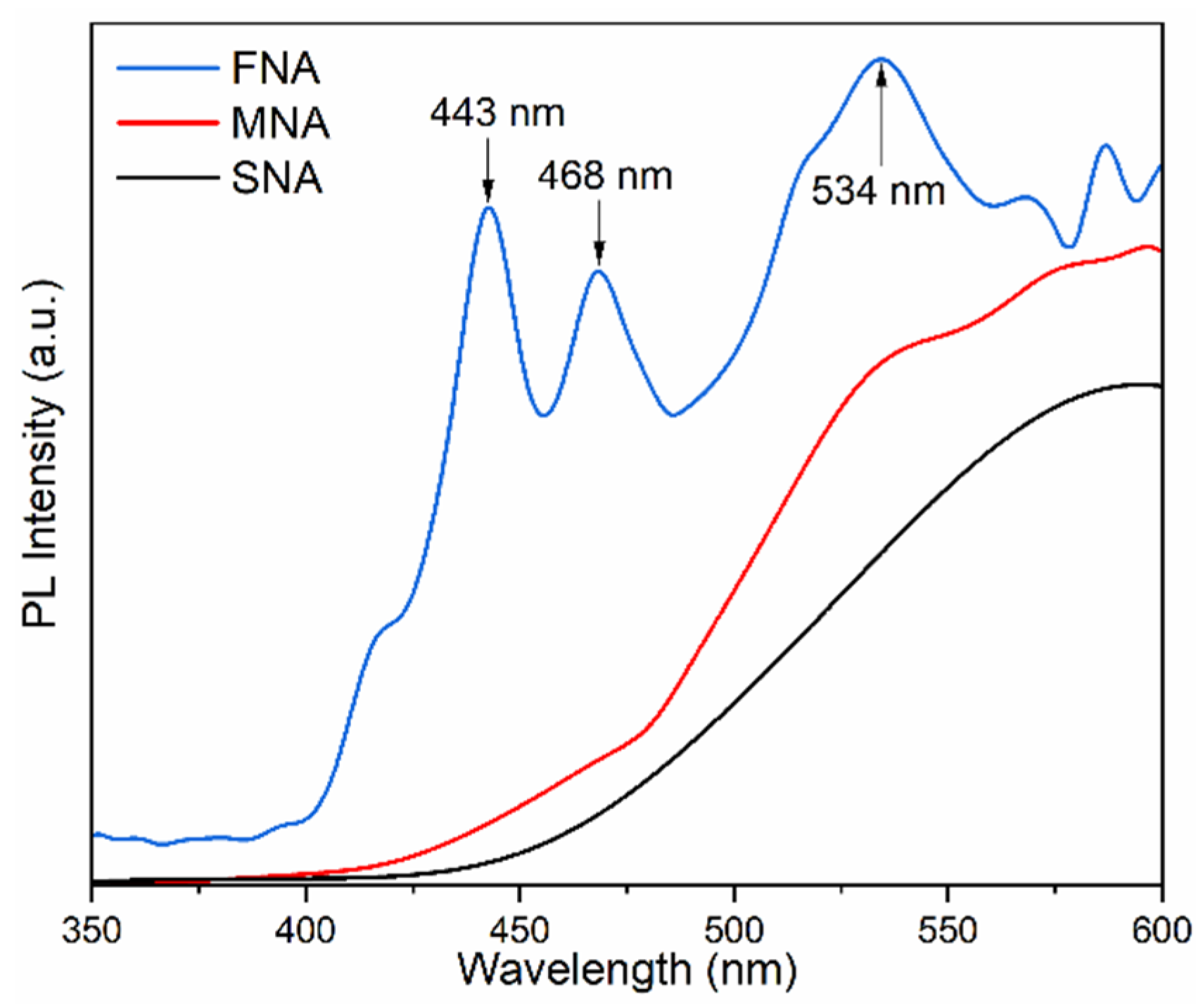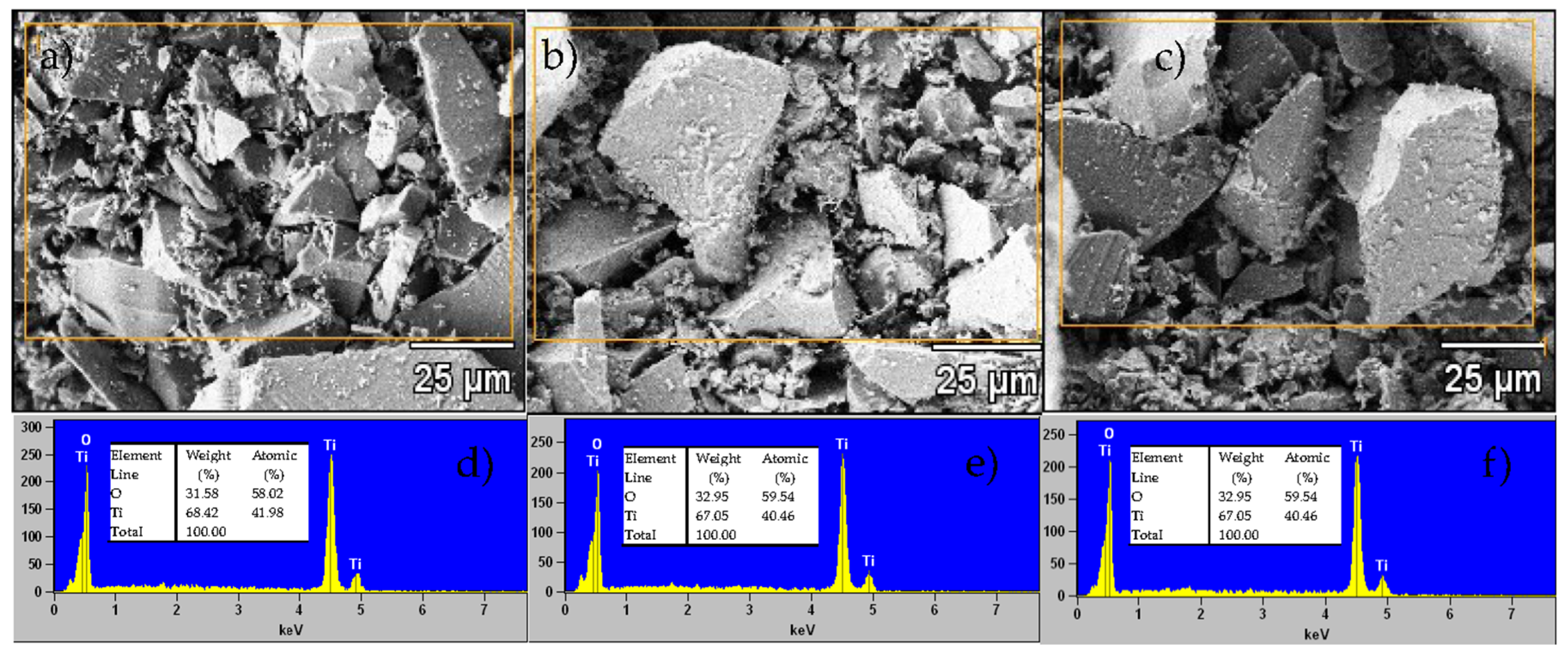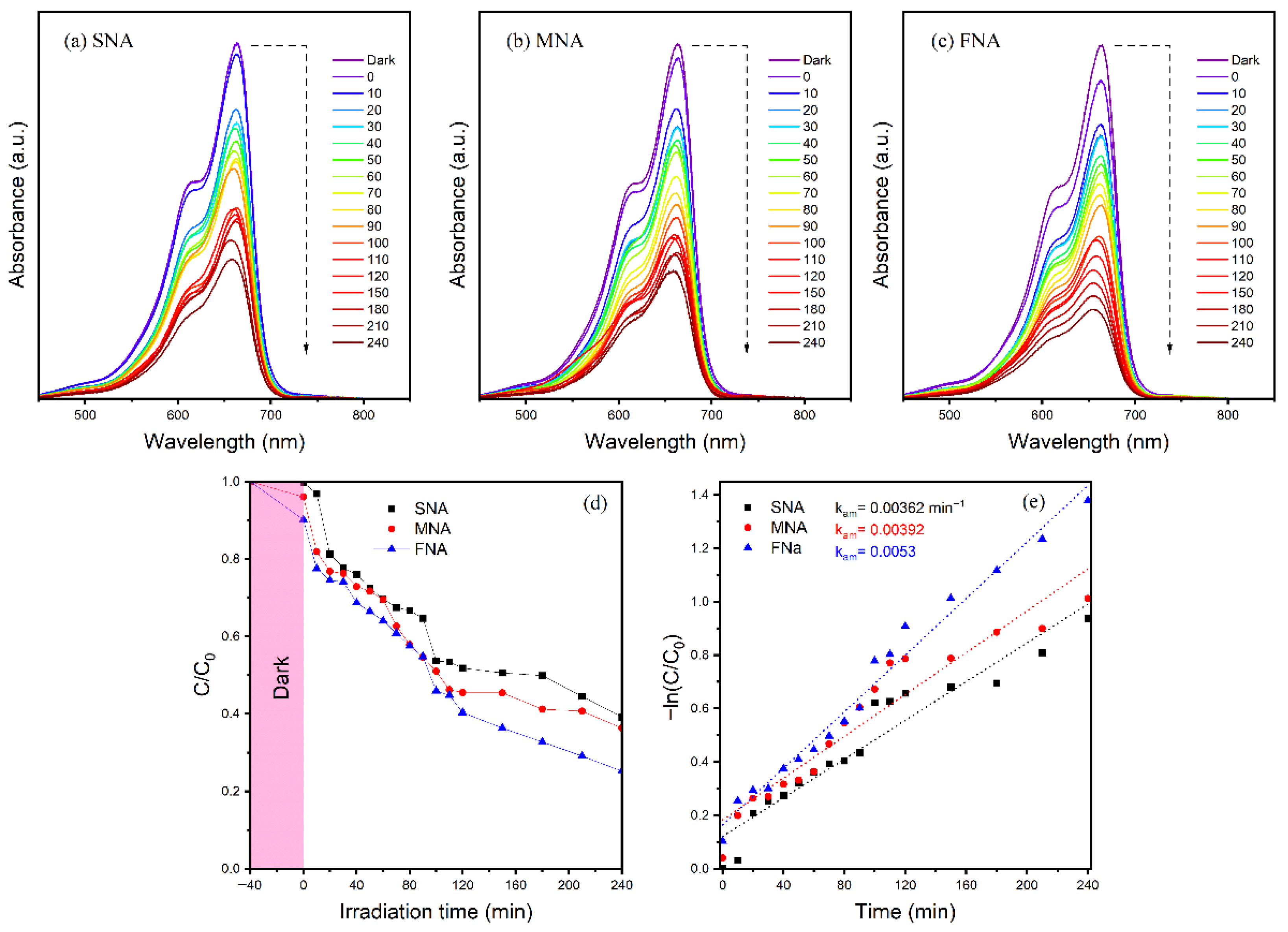Nitric Acid-Assisted Sol–Gel Synthesis of Defect-Rich TiO2 Nanoparticles: Structural Evolution and Visible-Light Photocatalytic Performance
Abstract
1. Introduction
2. Results and Discussion
2.1. X-Ray Diffraction
2.2. Raman Spectroscopy
2.3. UV-Vis
2.4. Analysis of Photoluminescence Spectroscopy
2.5. Scanning Electron Microscopy (SEM)
2.6. Photodegradation of MB
2.7. Proposed Mechanism for Visible-Light MB Degradation by TiO2
3. Experimental Details
3.1. Materials
3.2. Preparation of TiO2 NPS
3.3. Structural, Optical, and Morphological Characterization of the Films
3.4. Photocatalytic Activity Evaluation
4. Conclusions
Author Contributions
Funding
Institutional Review Board Statement
Informed Consent Statement
Data Availability Statement
Acknowledgments
Conflicts of Interest
References
- Dutta, S.; Gupta, B.; Srivastava, S.K.; Gupta, A.K. Recent advances on the removal of dyes from wastewater using various adsorbents: A critical review. Mater. Adv. 2021, 2, 4497–4531. [Google Scholar] [CrossRef]
- Linley, S.; Thomson, N.R. Environmental Applications of Nanotechnology: Nano-enabled Remediation Processes in Water, Soil and Air Treatment. Water Air Soil Pollut. 2021, 232, 59. [Google Scholar] [CrossRef]
- Wang, D.M. Environmental protection in clothing industry. In Proceedings of the 2015 International Conference on Sustainable Development (ICSD2015), Wuhan, China, 25–27 September 2015; pp. 729–735. [Google Scholar] [CrossRef]
- Chandanshive, V.; Kadam, S.; Rane, N.; Jeon, B.-H.; Jadhav, J.; Govindwar, S. In situ textile wastewater treatment in high rate transpiration system furrows planted with aquatic macrophytes and floating phytobeds. Chemosphere 2020, 252, 126513. [Google Scholar] [CrossRef]
- Santander, P.; Oyarce, E.; Sánchez, J. New insights in the use of a strong cationic resin in dye adsorption. Water Sci. Technol. 2020, 81, 773–780. [Google Scholar] [CrossRef]
- Maknun, L.; Nazriati, N.; Farida, I.; Kholila, N.; Syufa, R.B.M. Synthesis of Silica Xerogel based Bagasse Ash as a Methylene Blue Adsorbent on Textile Waste. J. Phys. Conf. Ser. 2018, 1093, 012050. [Google Scholar] [CrossRef]
- Mashkoor, F.; Nasar, A. Magsorbents: Potential candidates in wastewater treatment technology—A review on the removal of methylene blue dye. J. Magn. Magn. Mater. 2020, 500, 166408. [Google Scholar] [CrossRef]
- De Oliveira, G.A.R.; De Lapuente, J.; Teixidó, E.; Porredón, C.; Borràs, M.; De Oliveira, D.P. Textile dyes induce toxicity on zebrafish early life stages. Environ. Toxicol. Chem. 2015, 35, 429–434. [Google Scholar] [CrossRef] [PubMed]
- Santoso, E.; Ediati, R.; Kusumawati, Y.; Bahruji, H.; Sulistiono, D.O.; Prasetyoko, D. Review on recent advances of carbon based adsorbent for methylene blue removal from waste water. Mater. Today Chem. 2020, 16, 100233. [Google Scholar] [CrossRef]
- Oyarce, E.; Butter, B.; Santander, P.; Sánchez, J. Polyelectrolytes applied to remove methylene blue and methyl orange dyes from water via polymer-enhanced ultrafiltration. J. Environ. Chem. Eng. 2021, 9, 106297. [Google Scholar] [CrossRef]
- Li, H.; Lin, Y.; Luo, Y.; Yu, P.; Hou, L. Relating organic fouling of reverse osmosis membranes to adsorption during the reclamation of secondary effluents containing methylene blue and rhodamine B. J. Hazard. Mater. 2011, 192, 490–499. [Google Scholar] [CrossRef] [PubMed]
- Ihaddaden, S.; Aberkane, D.; Boukerroui, A.; Robert, D. Removal of methylene blue (basic dye) by coagulation-flocculation with biomaterials (bentonite and Opuntia ficus indica). J. Water Process Eng. 2022, 49, 102952. [Google Scholar] [CrossRef]
- Zhukova, A.I.; Sazonova, A.D.; Kharlanov, A.N.; Asabina, E.A.; Pet’kov, V.I.; Sedov, V.A.; Prokhin, V.D.; Osaulenko, D.A.; Fionov, Y.A.; Mikhalenko, I.I.; et al. Ethanol Dehydration Pathways on NASICON-Type A0.33M2(PO4)3 ((A = Dy, Y, Yb); M = Ti, Zr) Catalysts: The Role of Hydroxyl Group Proton Mobility in Selectivity Control. Catalysts 2025, 15, 515. [Google Scholar] [CrossRef]
- Karami, M.; Ghanbari, M.; Amiri, O.; Salavati-Niasari, M. Enhanced antibacterial activity and photocatalytic degradation of organic dyes under visible light using cesium lead iodide perovskite nanostructures prepared by hydrothermal method. Sep. Purif. Technol. 2020, 253, 117526. [Google Scholar] [CrossRef]
- Mekprasart, W.; Pecharapa, W. Synthesis and Characterization of Nitrogen-Doped Tio2 and Its Photocatalytic Activity Enhancement Under Visible Light. Energy Procedia 2011, 9, 509–514. [Google Scholar] [CrossRef]
- Viana, M.M.; Soares, V.F.; Mohallem, N.D.S. Synthesis and characterization of TiO2 nanoparticles. Ceram. Int. 2010, 36, 2047–2053. [Google Scholar] [CrossRef]
- Yin, H.; Wada, Y.; Kitamura, T.; Kambe, S.; Murasawa, S.; Mori, H.; Sakata, T.; Yanagida, S. Hydrothermal synthesis of nanosized anatase and rutile TiO2 using amorphous phase TiO2. J. Mater. Chem. 2001, 11, 1694–1703. [Google Scholar] [CrossRef]
- Kathirvel, S.; Pedaballi, S.; Su, C.; Chen, B.-R.; Li, W.-R. Morphological control of TiO2 nanocrystals by solvothermal synthesis for dye-sensitized solar cell applications. Appl. Surf. Sci. 2020, 519, 146082. [Google Scholar] [CrossRef]
- Anandgaonker, P.; Kulkarni, G.; Gaikwad, S.; Rajbhoj, A. Synthesis of TiO2 nanoparticles by electrochemical method and their antibacterial application. Arab. J. Chem. 2015, 12, 1815–1822. [Google Scholar] [CrossRef]
- Islam, M.T.; Roni, M.N.P.; Ali, M.Y.; Islam, M.R.; Hossan, M.S.; Rahman, M.H.; Zahid, A.A.S.M.; Alam, M.N.E.; Hanif, M.A.; Akhtar, M.S. Selectivity of Sol-Gel and Hydrothermal TiO2 Nanoparticles towards Photocatalytic Degradation of Cationic and Anionic Dyes. Molecules 2023, 28, 6834. [Google Scholar] [CrossRef]
- Navarro, L.K.T.; Jaroslav, C. Enhancing Photocatalytic Properties of TiO2 Photocatalyst and Heterojunctions: A Comprehensive Review of the Impact of Biphasic Systems in Aerogels and Xerogels Synthesis, Methods, and Mechanisms for Environmental Applications. Gels 2023, 9, 976. [Google Scholar] [CrossRef]
- Ramazani, M.; Farahmandjou, M.; Firoozabadi, T.P. Effect of Nitric Acid on Particle Morphology of the Nano-TiO2. Available online: https://www.ijnnonline.net/article_13474.html (accessed on 23 October 2025).
- Wang, Z.; Xia, D.; Chen, G.; Yang, T.; Chen, Y. The effects of different acids on the preparation of TiO2 nanostructure in liquid media at low temperature. Mater. Chem. Phys. 2008, 111, 313–316. [Google Scholar] [CrossRef]
- Park, J.; Bae, W.B.; Byun, S.W.; Shin, H.; Min, H.; Kim, Y.J.; Kang, S.B. Improvement of Catalytic Methane Oxidation by Nitric Acid Treatment on Pt/TiO2. Adv. Energy Sustain. Res. 2025, 6, 2400358. [Google Scholar] [CrossRef]
- Acosta-Silva, Y.J.; Gallardo-Hernández, S.; Rivas, S.; Espejel-Ayala, F.; Méndez-López, A. Photocatalytic Activities of Methylene Blue Using ZrO2 Thin Films at Different Annealing Temperatures. Coatings 2024, 14, 537. [Google Scholar] [CrossRef]
- Leyva-Porras, C.; Toxqui-Teran, A.; Vega-Becerra, O.; Miki-Yoshida, M.; Rojas-Villalobos, M.; García-Guaderrama, M.; Aguilar-Martínez, J.A. Low-temperature synthesis and characterization of anatase TiO2 nanoparticles by an acid assisted sol–gel method. J. Alloys Compd. 2015, 647, 627–636. [Google Scholar] [CrossRef]
- Thomas, W.; Krishnan, B.; Avellaneda, D.A.; Sanchez, E.O.G.; Martinez, J.A.A.; Shaji, S. Defects induced SnOx-TiO2 nanocomposite thin films for improved visible light driven photocatalysis and photoelectrochemical applications. Appl. Surf. Sci. 2024, 669, 160575. [Google Scholar] [CrossRef]
- Oruç, P.; Turan, N.; Cavdar, S.; Tuğluoğlu, N.; Koralay, H. Investigation of dielectric properties of amorphous, anatase, and rutile TiO2 structures. J. Mater. Sci. Mater. Electron. 2023, 34, 498. [Google Scholar] [CrossRef]
- Jose, S.; Selvi, K.; Bhuvana, K.P.; Bensingh, R.J. Inducing Multicolour emission in MEH-PPV/TiO2 nanocomposites. Opt. Mater. 2024, 157, 116321. [Google Scholar] [CrossRef]
- Kignelman, G.; Thielemans, W. Synergistic effects of acetic acid and nitric acid in water-based sol–gel synthesis of crystalline TiO2 nanoparticles at 25 °C. J. Mater. Sci. 2021, 56, 16877–16886. [Google Scholar] [CrossRef]
- Bischoff, B.L.; Anderson, M.A. Peptization Process in the Sol-Gel Preparation of Porous Anatase (TiO2). Chem. Mater. 1995, 7, 1772–1778. [Google Scholar] [CrossRef]
- Xu, C.Y.; Zhang, P.X.; Yan, L. Blue shift of Raman peak from coated TiO2 nanoparticles. J. Raman Spectrosc. 2001, 32, 862–865. [Google Scholar] [CrossRef]
- Choi, H.C.; Jung, Y.M.; Kim, S.B. Size effects in the Raman spectra of TiO2 nanoparticles. Vib. Spectrosc. 2004, 37, 33–38. [Google Scholar] [CrossRef]
- Ziashahabi, A.; Poursalehi, R.; Naseri, N.; Peymani, R. Shed light on defect induced enhanced visible-light photocatalysis activity of rutile TiO2 nanoparticles: Effects of annealing on blue-gray to light-gray transition. J. Mater. Res. Technol. 2022, 17, 2400–2409. [Google Scholar] [CrossRef]
- Etacheri, V.; Di Valentin, C.; Schneider, J.; Bahnemann, D.; Pillai, S.C. Visible-light activation of TiO2 photocatalysts: Advances in theory and experiments. J. Photochem. Photobiol. C Photochem. Rev. 2015, 25, 1–29. [Google Scholar] [CrossRef]
- Mousa, H.M.; Alenezi, J.F.; Mohamed, I.M.A.; Yasin, A.S.; Hashem, A.-F.M.; Abdal-Hay, A. Synthesis of TiO2@ZnO heterojunction for dye photodegradation and wastewater treatment. J. Alloys Compd. 2021, 886, 161169. [Google Scholar] [CrossRef]
- Chachuli, S.A.M.; Hamidon, M.N.; Ertugrul, M.; Mamat, S.; Jaafar, H.; Aris, N. Influence of B2O3 Addition on the Properties of TiO2 Thick Film at Various Annealing Temperatures for Hydrogen Sensing. J. Electron. Mater. 2020, 49, 3340–3349. [Google Scholar] [CrossRef]
- Enyashin, A.N.; Seifert, G. Structure, stability and electronic properties of TiO2 nanostructures. Phys. Status Solidi (B) 2005, 242, 1361–1370. [Google Scholar] [CrossRef]
- Tsega, M.; Dejene, F.B. Influence of acidic pH on the formulation of TiO2 nanocrystalline powders with enhanced photoluminescence property. Heliyon 2017, 3, e00246. [Google Scholar] [CrossRef]
- Chen, D.; Cheng, Y.; Zhou, N.; Chen, P.; Wang, Y.; Li, K.; Huo, S.; Cheng, P.; Peng, P.; Zhang, R.; et al. Photocatalytic degradation of organic pollutants using TiO2-based photocatalysts: A review. J. Clean. Prod. 2020, 268, 121725. [Google Scholar] [CrossRef]
- Nawaz, R.; Hanafiah, M.M.; Sakawi, Z.; Baki, Z.A.; Abidin, S.B.Z.; Anjum, M.; Ismail, A.F.; Arshad, U. A review of the defective TiO2 materials-based photocatalysis for environmental remediation: Exploring the nexus between light wavelength and energy consumption. Appl. Energy 2025, 393, 126143. [Google Scholar] [CrossRef]
- Kathirvel, S.; Su, C.; Shiao, Y.-J.; Lin, Y.-F.; Chen, B.-R.; Li, W.-R. Solvothermal synthesis of TiO2 nanorods to enhance photovoltaic performance of dye-sensitized solar cells. Sol. Energy 2016, 132, 310–320. [Google Scholar] [CrossRef]
- La, M.-P.; Shiu, J.-W.; Way, T.-F.; Rwei, S.-P. Synthesis and Characterization of Size-Controlled Titania Nanorods through Double Surfactants. Inorg. Chem. 2021, 60, 7952–7960. [Google Scholar] [CrossRef]
- Geçgel, C.; Yabalak, E.; Turabik, M. Simultaneous synthesis of super-paramagnetic hydrochar in a one-pot using subcritical water medium and evaluation of its photocatalytic activity. J. Environ. Manag. 2024, 362, 121333. [Google Scholar] [CrossRef]
- Kar, P.; Aggarwal, D.; Shukla, K.; Gupta, R.K. Defect State Modulation of TiO2 Nanostructures for Photocatalytic Abatement of Emerging Pharmaceutical Pollutant in Wastewater Effluent. Adv. Energy Sustain. Res. 2021, 3, 2100162. [Google Scholar] [CrossRef]
- De Jesús Acosta-Silva, Y.; Toledano-Ayala, M.; Gallardo-Hernández, S.; Godínez, L.A.; Méndez-López, A. Investigation of TiO2 Deposit on SiO2 Films: Synthesis, Characterization, and Efficiency for the Photocatalytic Discoloration of Methylene Blue in Aqueous Solution. Nanomaterials 2023, 13, 1403. [Google Scholar] [CrossRef]
- Athithya, S.; Manikandan, V.S.; Harish, S.K.; Silambarasan, K.; Gopalakrishnan, S.; Ikeda, H.; Navaneethan, M.; Archana, J. Plasmon Effect of Ag Nanoparticles on TiO2/rGO Nanostructures for Enhanced Energy Harvesting and Environmental Remediation. Nanomaterials 2022, 13, 65. [Google Scholar] [CrossRef]
- Babyszko, A.; Wanag, A.; Kusiak-Nejman, E.; Morawski, A.W. Effect of Calcination Temperature of SiO2/TiO2 Photocatalysts on UV-VIS and VIS Removal Efficiency of Color Contaminants. Catalysts 2023, 13, 186. [Google Scholar] [CrossRef]
- Huang, H.; Kong, Q.; Yue, X.; Wang, K.; Wei, Z.; Chang, Y. Fabrication and Photocatalytic Activity of Single Crystalline TiO2 Hierarchically Structured Microspheres. Catalysts 2023, 13, 201. [Google Scholar] [CrossRef]
- Acosta-Silva, Y.J.; Lugo-Arredondo, M.I.; Gallardo-Hernández, S.; Garcia-Trejo, J.F.; Matsumoto, Y.; Rivas, S.; Feregrino-Pérez, A.A.; Godínez, L.A.; Méndez-López, A. Comparison of Photocatalytic Activity: Impact of Hydrophilic Properties on TiO2 and ZrO2 Thin Films. Inorganics 2024, 12, 320. [Google Scholar] [CrossRef]







| Calculated Parameters | SNA | MNA | FNA |
|---|---|---|---|
| FWHM (degree) | 0.7528 | 0.6512 | 0.5486 |
| Lattice constant (Å) | a = b = 3.788, c = 9.469 | a = b = 3.783, c = 9.478 | a = b = 3.781, c = 9.469 |
| d-Spacing (Å) | 3.517 | 3.539 | 3.518 |
| Unit cell volume, a2c (Å3) | 135.870 | 135.641 | 135.368 |
| Average crystallite size (nm) | 11.30 | 13.05 | 15.50 |
| Density, q (g/cm3) | 3.90 | 3.91 | 3.92 |
| Specific surface area, Sa (m2/g) | 136.1 | 117.5 | 98.8 |
Disclaimer/Publisher’s Note: The statements, opinions and data contained in all publications are solely those of the individual author(s) and contributor(s) and not of MDPI and/or the editor(s). MDPI and/or the editor(s) disclaim responsibility for any injury to people or property resulting from any ideas, methods, instructions or products referred to in the content. |
© 2025 by the authors. Licensee MDPI, Basel, Switzerland. This article is an open access article distributed under the terms and conditions of the Creative Commons Attribution (CC BY) license (https://creativecommons.org/licenses/by/4.0/).
Share and Cite
Acosta-Silva, Y.J.; Gallardo-Hernández, S.; Aguirre-Becerra, H.; García-Trejo, J.F.; Matsumoto, Y.; Méndez-López, A. Nitric Acid-Assisted Sol–Gel Synthesis of Defect-Rich TiO2 Nanoparticles: Structural Evolution and Visible-Light Photocatalytic Performance. Inorganics 2025, 13, 382. https://doi.org/10.3390/inorganics13120382
Acosta-Silva YJ, Gallardo-Hernández S, Aguirre-Becerra H, García-Trejo JF, Matsumoto Y, Méndez-López A. Nitric Acid-Assisted Sol–Gel Synthesis of Defect-Rich TiO2 Nanoparticles: Structural Evolution and Visible-Light Photocatalytic Performance. Inorganics. 2025; 13(12):382. https://doi.org/10.3390/inorganics13120382
Chicago/Turabian StyleAcosta-Silva, Y. J., S. Gallardo-Hernández, H. Aguirre-Becerra, J. F. García-Trejo, Y. Matsumoto, and A. Méndez-López. 2025. "Nitric Acid-Assisted Sol–Gel Synthesis of Defect-Rich TiO2 Nanoparticles: Structural Evolution and Visible-Light Photocatalytic Performance" Inorganics 13, no. 12: 382. https://doi.org/10.3390/inorganics13120382
APA StyleAcosta-Silva, Y. J., Gallardo-Hernández, S., Aguirre-Becerra, H., García-Trejo, J. F., Matsumoto, Y., & Méndez-López, A. (2025). Nitric Acid-Assisted Sol–Gel Synthesis of Defect-Rich TiO2 Nanoparticles: Structural Evolution and Visible-Light Photocatalytic Performance. Inorganics, 13(12), 382. https://doi.org/10.3390/inorganics13120382







